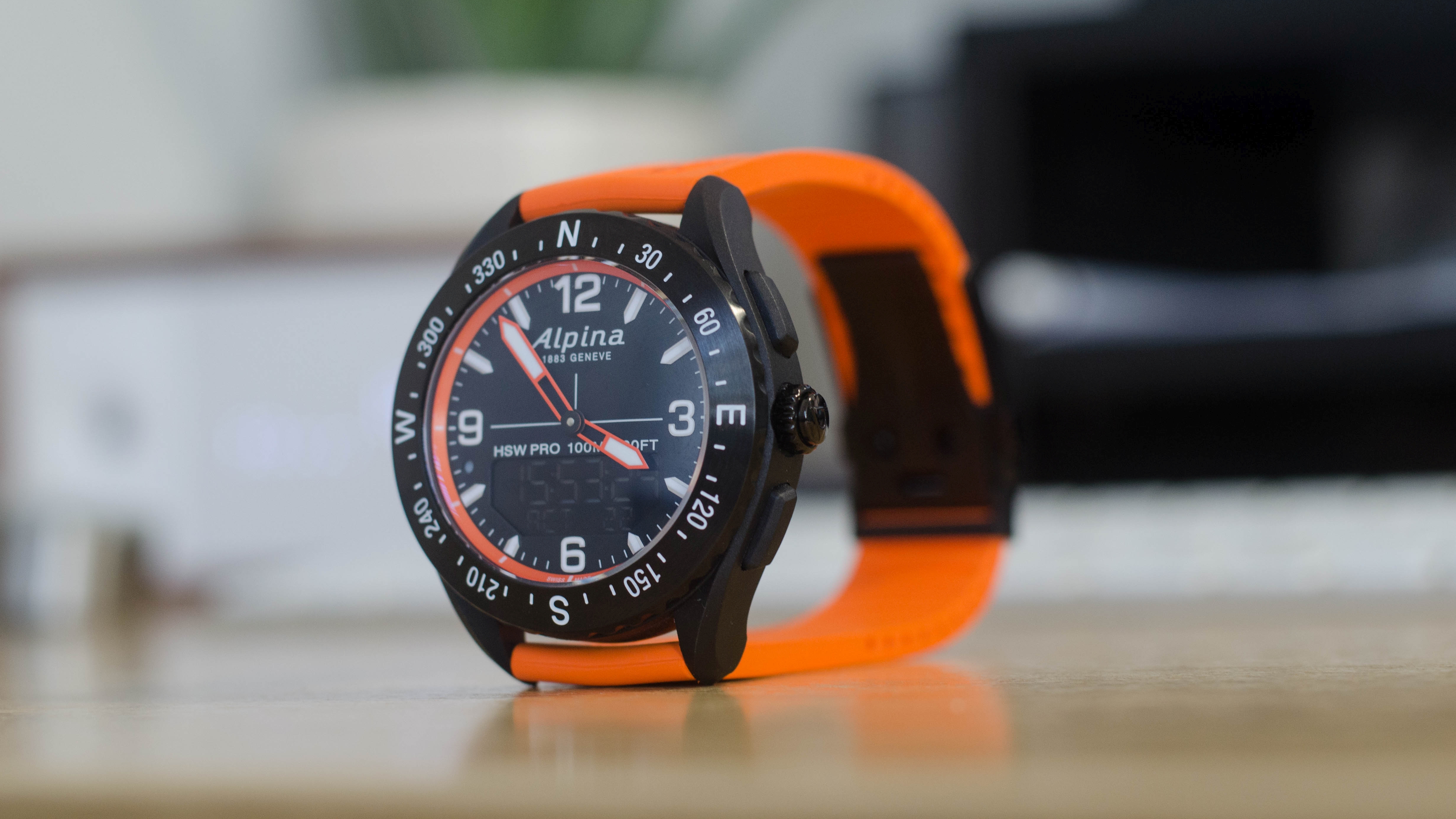Why you can trust TechRadar
Specs, features and performance
- Barometer, altimeter, compass, UV monitor and thermometer
- Watch needs removing to use thermometer accurately
- Smartphone app logs data recorded by every sensor
Equipped with an MMT-283-1 movement, the Alpina AlpinerX works in a similar way to other Swiss smartwatches.
Instead of a traditional quartz, wound, or self-winding mechanism, the watch keeps time by connecting to your smartphone; if you travel to a different time zone, the watch will adjust as soon as your phone does. If this fails for whatever reason, the watch hands can be calibrated using the app.
While this is fine, we found it somewhat frustrating that features like a countdown timer with alarm cannot be adjusted on the watch itself. By default, the function offers a five-minute countdown, but to change this you have to dig into the smartphone app, which doesn’t have the most intuitive layout.
To change the length of the timer, for example, you open the app, then head to the ‘My Watch’ section (not the equally vague ‘General’) then make the change. All this for setting a simple stopwatch feels cumbersome.
Rewinding for a moment, we should say the AlpinerX is easy to set up and pair via Bluetooth to your smartphone. Its connection isn’t always the most stable, with the app sometimes saying the watch isn’t connected, but a press of the crown fixes this in just a couple of seconds.

Viewing data collected by each of the sensors is a case of pressing the crown button repeatedly until the reading you want appears on the small display. The order of these can be adjusted in the smartphone app, and any reading you don’t require can be hidden.
Readings are displayed quickly, and most will remain on the display until you move to the next one with another press of the crown - however, due to it requiring more battery power, the compass only remains active for a few seconds at a time.
We can see outdoors folk getting some real use from these features, especially as data collected is sent to the phone app, which produces graphs of the elevation changes you encountered on your hike.

UV light monitoring is also a great inclusion, but as with the barometer readings, a prior understanding of what the readings mean would help novices get the most out of them.
While the numbers themselves are perfectly legible - for UV exposure, for example, or the atmospheric pressure - the name and description for each is heavily abbreviated to fit on the screen.
For example, 'SLP 98' means you slept for 98% of your goal last night, while 'ACT 22' means 22% of your daily activity goal has been completed and 'TMZ' refers to the watch’s second time zone. You will eventually remember what everything means, but at first glance it can feel confusing.

The AlpinerX’s small screen can also handle notifications from your phone, such as calls and messages through Facebook, WhatsApp, Instagram, Twitter and email. To notify you of these, the watch beeps and shows ‘1’ on the display, along with an abbreviated description of what’s going on.
Again, however, it isn’t particularly clear. For example, a WhatsApp message from a contact called Rupert would be displayed as 'WHA RUP', or an email from James would be 'EMA JAM'.
The lack of a vibration motor means you are highly likely to miss these notifications anyway, so we would suggest you switch them off and let the AlpinerX focus on being an adventure watch, not a personal assistant.
The AlpinerX does an admirable job of cramming a lot of sensors and readings into a relatively compact design, and being able to access such a breadth of data right on your wrist will be a real boon to hikers, climbers and other outdoor enthusiasts.
Health and fitness
- Sleep tracking with dynamic alarm
- Lacking a heart rate monitor
Like almost all hybrid smartwatches, the AlpinerX uses its accelerometer to measure your movement, steps, sleep and exercise.
The companion app logs your steps and sleep each day, and when you select the running tool on the watch itself it tracks your runs, too, showing them on a map and displaying your average speed along the route.
Sleep can be tracked by either wearing the AlpinerX on your wrist, or by placing it on the pillow, although we found the latter to be less accurate. After wearing the watch for a night, the app shows how long you slept in total, but also breaks this down into light sleep, deep sleep and time spent awake.

Not everyone will want to wear a watch as large as the AlpinerX to bed every night, but we were surprised at how little its presence disturbed our sleep; the lightweight case must certainly have helped here.
Step and run tracking seemed accurate to us, but the latter requires you keep your phone with you, as the watch does not have GPS, so borrows that of your phone to log its location.
The app is very similar to that used by parent company Frederique Constant, complete with a virtual coach of sorts, which displays messages of encouragement based on what you do.

This sounds useful, but the ‘coach tips’ often just state the obvious and are not particularly helpful. One states: “Avoid stress one hour prior to sleep by avoiding chores or work you do not enjoy. Deep breathing and stretching will help.”
We felt the AlpinerX’s fitness tracking is about on par with other hybrid watches, but the lack of a heart rate monitor is disappointing when rivals like the newly launched Withings Steel HR Sport track your heart for far less money - albeit with a battery life measured in weeks instead of years.
The outdoors fans this watch is aimed at could well appreciate how it tracks their steps, runs and sleep - on top of everything else it does - but we suspect fitness fanatics will be less likely to part with their cash.
The app feels quite basic and the lack of a heart rate monitor will make the AlpinerX a non-starter for many in search of a fitness device.

Battery life
- Alpina claims two years of battery life
- Takes a regular non-rechargeable watch battery
Alpina claims the AlpinerX will last for two years on its regular watch battery, but of course this will depend a lot on how you use it. As we alluded to earlier, the compass draws more power than the watch’s other features, so regular use will see that two-year claim tumble.
That said, we like how the Alpina AlpinerX manages to offer a wide range of smart features without asking to be recharged every few days, or even monthly.
Current page: Specs, fitness and battery life
Prev Page Introduction, price and design Next Page VerdictAlistair Charlton is based in London and has worked as a freelance technology and automotive journalist for over a decade. A lifelong tech enthusiast, Alistair has written extensively about dash cams and robotic vacuum cleaners for TechRadar, among other products. As well as TechRadar, he also writes for Wired, T3, Forbes, The Independent, Digital Camera World and Grand Designs Magazine, among others.

